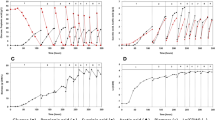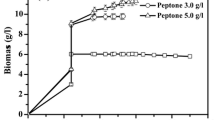Abstract
In this study, we discussed the development and optimization of an intensified CHO culture process, highlighting medium and control strategies to improve lactate metabolism. A few strategies, including supplementing glucose with other sugars (fructose, maltose, and galactose), controlling glucose level at <0.2 mM, and supplementing medium with copper sulfate, were found to be effective in reducing lactate accumulation. Among them, copper sulfate supplementation was found to be critical for process optimization when glucose was in excess. When copper sulfate was supplemented in the new process, two-fold increase in cell density (66.5 ± 8.4 × 106 cells/mL) and titer (11.9 ± 0.6 g/L) was achieved. Productivity and product quality attributes differences between batch, fed-batch, and concentrated fed-batch cultures were discussed. The importance of process and cell metabolism understanding when adapting the existing process to a new operational mode was demonstrated in the study.









Similar content being viewed by others
References
Abu-Absi S, Xu S, Graham H, Dalal N, Boyer M, Dave K (2014) Cell culture process operations for recombinant protein production. Adv Biochem Eng Biotechnol 139:35–68
Luan YT, Mutharasan R, Magee WE (1987) Strategies to extend longevity of hybridomas in culture and promote yield of monoclonal antibodies. Biotechnol Lett 9:691–696
Bibila TA, Robinson DK (1995) In pursuit of the optimal fed-batch process for monoclonal antibody production. Biotechnol Prog 11:1–13
Merten OW, Cruz PE, Rochette C, Geny-Fiamma C, Bouquet C, Gonçalves D, Danos O, Carrondo MJT (2001) Comparison of different bioreactor systems for the production of high titer retroviral vectors. Biotechnol Prog 17:326–335
Huang Y-M, Hu W, Rustandi E, Chang K, Yusuf-Makagiansar H, Ryll T (2010) Maximizing productivity of CHO cell-based fed-batch culture using chemically defined media conditions and typical manufacturing equipment. Biotechnol Prog 26:1400–1410
Lu F, Toh PC, Burnett I, Li F, Hudson T, Amanullah A, Li J (2013) Automated dynamic fed-batch process and media optimization for high productivity cell culture process development. Biotechnol Bioeng 110:191–205
Ma N, Ellet J, Okediadi C, Hermes P, McCormick E, Casnocha S (2009) A single nutrient feed supports both chemically defined NS0 and CHO fed-batch processes: improved productivity and lactate metabolism. Biotechnol Prog 25:1353–1363
Gagnon M, Hiller G, Luan Y-T, Kittredge A, DeFelice J, Drapeau D (2011) High-end pH-controlled delivery of glucose effectively suppresses lactate accumulation in CHO fed-batch cultures. Biotechnol Bioeng 108:1328–1337
Konstantinov K, Goudar C, Ng M, Meneses R, Thrift J, Chuppa S, Matanguihan C, Michaels J, Naveh D (2006) The “push-to-low” approach for optimization of high-density perfusion cultures of animal cells. Adv Biochem Eng Biotechnol 101:75–98
Warikoo V, Godawat R, Brower K, Jain S, Cummings D, Simons E, Johnson T, Walther J, Yu M, Wright B, McLarty J, Karey KP, Hwang C, Zhou W, Riske F, Konstantinov K (2012) Integrated continuous production of recombinant therapeutic proteins. Biotechnol Bioeng 109:3018–3029
Clincke M-F, Mölleryd C, Zhang Y, Lindskog E, Walsh K, Chotteau V (2013) Very high density of CHO cells in perfusion by ATF or TFF in WAVE bioreactor™. Part I. Effect of the cell density on the process. Biotechnol Prog 29:754–767
Lim J, Sinclair A, Shevitz J, Bonham-Carter J (2011) An economic comparison of three cell culture techniques. Biopharm Int 24:54–60
Zijlstra G (2013) New approaches in continuous biomanufacturing: continuous XD® cell cultures (at 100 million cells/mL and beyond) coupled to the Rhobust® EBA integrated clarification and purification technology. Integrated continuous biomanufacturing. Castelldefels, Spain
Yang WC, Minkler DF, Kshirsagar R, Ryll T, Huang Y-M (2016) Concentrated fed-batch cell culture increases manufacturing capacity without additional volumetric capacity. J Biotechnol 217:1–11
Han YK, Kim Y-G, Kim JY, Lee GM (2010) Hyperosmotic stress induces autophagy and apoptosis in recombinant Chinese hamster ovary cell culture. Biotechnol Bioeng 105:1187–1192
Zhu MM, Goyal A, Rank DL, Gupta SK, Boom TV, Lee SS (2005) Effects of elevated pCO2 and osmolality on growth of CHO cells and production of antibody-fusion protein B1: a case study. Biotechnol Prog 21:70–77
Osman JJ, Birch J, Varley J (2002) The response of GS-NS0 myeloma cells to single and multiple pH perturbations. Biotechnol Bioeng 79:398–407
Langheinrich C, Nienow AW (1999) Control of pH in large-scale, free suspension animal cell bioreactors: alkali addition and pH excursions. Biotechnol Bioeng 66:171–179
Xu S, Abu-Absi S, Pla I, Maranga L (2014) Scale dependence of lactate metabolism in mammalian cell cultures. ACS Spring Meeting, Dallas, TX
Qian Y, Khattak SF, Xing Z, He A, Kayne PS, Qian N-X, Pan S-H, Li ZJ (2011) Cell culture and gene transcription effects of copper sulfate on Chinese hamster ovary cells. Biotechnol Prog 27:1190–1194
Luo J, Vijayasankaran N, Autsen J, Santuray R, Hudson T, Amanullah A, Li F (2012) Comparative metabolite analysis to understand lactate metabolism shift in Chinese hamster ovary cell culture process. Biotechnol Bioeng 109:146–156
Kang S, Xiao G, Ren D, Zhang Z, Le N, Trentalange M, Gupta S, Lin H, Bondarenko PV (2014) Proteomics analysis of altered cellular metabolism induced by insufficient copper level. J Biotechnol 189:15–26
Yuk IH, Russell S, Tang Y, Hsu W-T, Mauger JB, Aulakh RPS, Luo J, Gawlitzek M, Joly JC (2015) Effects of copper on CHO cells: cellular requirements and product quality considerations. Biotechnol Prog 31:226–238
Ishida S, Andreux P, Poitry-Yamate C, Auwerx J, Hanahan D (2013) Bioavailable copper modulates oxidative phosphorylation and growth of tumors. Proc Natl Acad Sci USA 110:19507–19512
Zagari F, Jordan M, Stettler M, Broly H, Wurm FM (2013) Lactate metabolism shift in CHO cell culture: the role of mitochondrial oxidative activity. N Biotechnol 30:238–245
Mulukutla BC, Yongky A, Grimm S, Daoutidis P, Hu W-S (2015) Multiplicity of steady states in glycolysis and shift of metabolic state in cultured mammalian cells. PLoS One 10:e0121561
Altamirano C, Paredes C, Cairó JJ, Gòdia F (2000) Improvement of CHO cell culture medium formulation: simultaneous substitution of glucose and glutamine. Biotechnol Prog 16:69–75
Glacken MW, Fleischaker RJ, Sinskey AJ (1986) Reduction of waste product excretion via nutrient control: possible strategies for maximizing product and cell yields on serum in cultures of mammalian cells. Biotechnol Bioeng 28:1376–1389
Wlaschin KF, Hu W-S (2007) Engineering cell metabolism for high-density cell culture via manipulation of sugar transport. J Biotechnol 131:168–176
Berrios J, Altamirano C, Osses N, Gonzalez R (2011) Continuous CHO cell cultures with improved recombinant protein productivity by using mannose as carbon source: metabolic analysis and scale-up simulation. Chem Eng Sci 66:2431–2439
Plagemann PG, Wohlhueter RM, Graff J, Erbe J, Wilkie P (1981) Broad specificity hexose transport system with differential mobility of loaded and empty carrier, but directional symmetry, is common property of mammalian cell lines. J Biol Chem 256:2835–2842
Barngrover D, Thomas J, Thilly WG (1985) High density mammalian cell growth in Leibovitz bicarbonate-free medium: effects of fructose and galactose on culture biochemistry. J Cell Sci 78:173–189
Grainger RK, James DC (2013) CHO cell line specific prediction and control of recombinant monoclonal antibody N-glycosylation. Biotechnol Bioeng 110:2970–2983
Gramer MJ, Eckblad JJ, Donahue R, Brown J, Shultz C, Vickerman K, Priem P, van den Bremer ETJ, Gerritsen J, van Berkel PHC (2011) Modulation of antibody galactosylation through feeding of uridine, manganese chloride, and galactose. Biotechnol Bioeng 108:1591–1602
Hossler P, Wang M, McDermott S, Racicot C, Chemfe K, Zhang Y, Chumsae C, Manuilov A (2015) Cell culture media supplementation of bioflavonoids for the targeted reduction of acidic species charge variants on recombinant therapeutic proteins. Biotechnol Prog 31:1039–1052
Kishishita S, Nishikawa T, Shinoda Y, Nagashima H, Okamoto H, Takuma S, Aoyagi H (2015) Effect of temperature shift on levels of acidic charge variants in IgG monoclonal antibodies in Chinese hamster ovary cell culture. J Biosci Bioeng 119:700–705
Barnabé N, Butler M (1994) Effect of temperature on nucleotide pools and monoclonal antibody production in a mouse hybridoma. Biotechnol Bioeng 44:1235–1245
Sureshkumar GK, Mutharasan R (1991) The influence of temperature on a mouse–mouse hybridoma growth and monoclonal antibody production. Biotechnol Bioeng 37:292–295
Europa AF, Gambhir A, Fu P-C, Hu W-S (2000) Multiple steady states with distinct cellular metabolism in continuous culture of mammalian cells. Biotechnol Bioeng 67:25–34
Maranga L, Goochee CF (2006) Metabolism of PER.C6™ cells cultivated under fed-batch conditions at low glucose and glutamine levels. Biotechnol Bioeng 94:139–150
Chee Furng Wong D, Tin Kam Wong K, Tang Goh L, Kiat Heng C, Gek Sim Yap M (2005) Impact of dynamic online fed-batch strategies on metabolism, productivity and N-glycosylation quality in CHO cell cultures. Biotechnol Bioeng 89:164–177
Xu S, Gupta B, Hoshan L, Chen H (2015) Rapid early process development enabled by commercial chemically defined media and microbioreactors. Biopharm Int 28:28–33
Yongky A, Lee J, Le T, Mulukutla BC, Daoutidis P, Hu W-S (2015) Mechanism for multiplicity of steady states with distinct cell concentration in continuous culture of mammalian cells. Biotechnol Bioeng 112:1437–1445
Templeton N, Dean J, Reddy P, Young JD (2013) Peak antibody production is associated with increased oxidative metabolism in an industrially relevant fed-batch CHO cell culture. Biotechnol Bioeng 110:2013–2024
Charaniya S, Le H, Rangwala H, Mills K, Johnson K, Karypis G, Hu W-S (2010) Mining manufacturing data for discovery of high productivity process characteristics. J Biotechnol 147:186–197
Lee S-Y, Kwon Y-B, Cho J-M, Park K-H, Chang S-J, Kim D-I (2012) Effect of process change from perfusion to fed-batch on product comparability for biosimilar monoclonal antibody. Process Biochem 47:1411–1418
Meuwly F, Weber U, Ziegler T, Gervais A, Mastrangeli R, Crisci C, Rossi M, Bernard A, von Stockar U, Kadouri A (2006) Conversion of a CHO cell culture process from perfusion to fed-batch technology without altering product quality. J Biotechnol 123:106–116
Acknowledgments
We would like to thank Mike Caruso, Alejandro Baloco, Debra Lutz, and D’Juan Gibson for bioreactor operations and media preparation, Elizabeth Wu for titer assay, Heera Khan, Mike Rauscher, and Sonja Battle for purification and quality assays. We would also like to thank John Bowers, Balrina Gupta, and David Roush for critical review of the manuscript.
Author information
Authors and Affiliations
Corresponding author
Electronic supplementary material
Below is the link to the electronic supplementary material.
Rights and permissions
About this article
Cite this article
Xu, S., Hoshan, L. & Chen, H. Improving lactate metabolism in an intensified CHO culture process: productivity and product quality considerations. Bioprocess Biosyst Eng 39, 1689–1702 (2016). https://doi.org/10.1007/s00449-016-1644-3
Received:
Accepted:
Published:
Issue Date:
DOI: https://doi.org/10.1007/s00449-016-1644-3




